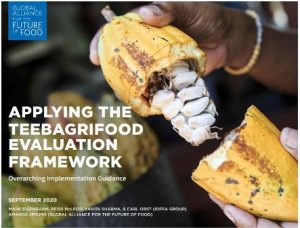Guide Launched for Assessing Food System Impact
This free-to-use collection of methodologies, case studies, and valuation approaches is useful to researchers, civil society organizations, policymakers, farmers, and the private sector when conducting a ‘true cost’ assessment in the field of agriculture and food systems.
The Global Alliance for the Future of Food launched The TEEBAgriFood Evaluation Framework: Overarching Implementation Guidance, a step-by-step guide to assess how food  systems impact people, society, the environment, and natural resources. Supported by a rich inventory of case studies, the TEEBAgriFood Framework (“The Economics of Ecosystems and Biodiversity”) enables users to identify a range of actions that can transform how food systems operate. Developed in partnership with the Institute for the Development of Environmental-Economic Accounting and the UN Environment Programme (UNEP), it helps to create a practical roadmap for action on biodiversity loss.
systems impact people, society, the environment, and natural resources. Supported by a rich inventory of case studies, the TEEBAgriFood Framework (“The Economics of Ecosystems and Biodiversity”) enables users to identify a range of actions that can transform how food systems operate. Developed in partnership with the Institute for the Development of Environmental-Economic Accounting and the UN Environment Programme (UNEP), it helps to create a practical roadmap for action on biodiversity loss.
Changing the tools used to assess food systems is an immediate way to take action that promotes human, animal, and planetary health. Simplistic economic productivity metrics like ‘yield-per-hectare’ mean that negative externalities – habitat destruction, soil erosion, water contamination, displacement of Indigenous Peoples, diabetes, and more – go unaccounted for in the final price of food, in policy documents, and on balance sheets (but the price is still paid). This also means that positive impacts – carbon sequestration, insect pollination, resilience to natural disasters, and vibrant communities – are hidden and can’t be enhanced.
The Guide is already being used by policymakers, investors, and farmers around the world to comprehensively evaluate their work, fill in the gaps, and make better decisions about the future. For example, a CONABIO valuation of maize production systems found that the lack of genetic diversity in corn grown in the USA and Canada – which makes them more vulnerable to pests and disease – resulted in yield losses of USD 27,403,616,604 between 2012 and 2015.
Genetically diverse crop species are more resistant and not subject to the same type of losses.
Also Read : Integrated Approach to Food Systems Required, Says FAO Report
According to Ruth Richardson, Executive Director, Global Alliance for the Future of Food, “As the pandemic challenges world leaders to confront the links between industrialized agricultural land use, habitat loss, and risks to public health, now is the time to seize new tools to inform policy and practice, leading markets towards healthy, resilient, and equitable food systems. Without being able to see the full picture of how food systems impact people and the planet, policymakers are simply flying blind in their efforts to deliver on the SDGs, climate, and biodiversity targets.”
Mark Eigenraam, Director at IDEEA Group and lead report author, said, “These ground-breaking guidelines are an important step towards transforming the world’s food systems. They provide practical steps for integrating natural capital with human and social capital to move beyond narrow measures of economic productivity. Business, government, and communities can now combine forces to achieve the UN Sustainable Development Goals related to poverty, food, health, and the environment.”
Dr Salman Hussain, Coordinator, The Economics of Ecosystems and Biodiversity, UNEP, said, “I am often asked by people interested in true cost accounting: ‘where do I start?’ I now have the answer. Authored by some of the great thought-leaders in food and agricultural systems, these new materials are a user-friendly and accessible resource for the community.”
The Guideis supported by The True Cost Accounting Inventory. Developed by the Global Alliance, Soil & More Impacts and TMG ThinkTank for Sustainability, this free-to-use collection of methodologies, case studies, and valuation approaches is useful to researchers, civil society organizations, policymakers, farmers, and the private sector when conducting a ‘true cost’ or TEEBAgriFood assessment in the field of agriculture and food systems.
The Global Alliance for the Future of Food is a strategic alliance of philanthropic foundations working together and with others to transform global food systems now and for future generations. It believes in the urgency of transforming global food systems, and in the power of working together and with others to effect positive change. Food systems reform requires new and better solutions at all scales through a systems-level approach and deep collaboration among philanthropy, researchers, grassroots movements, the private sector, farmers and food systems workers, Indigenous Peoples, government, and policymakers.
